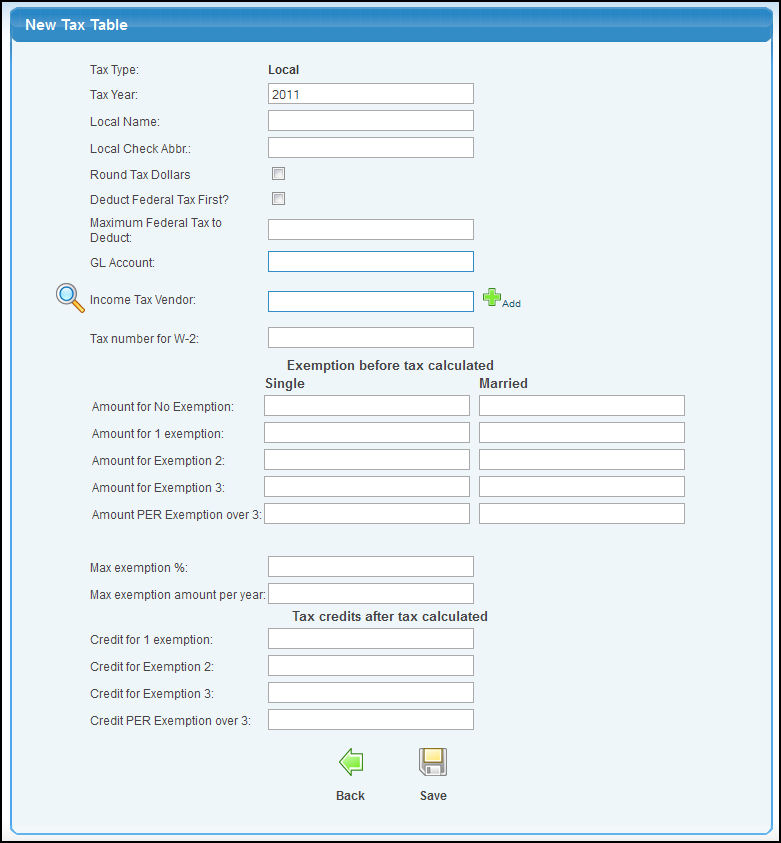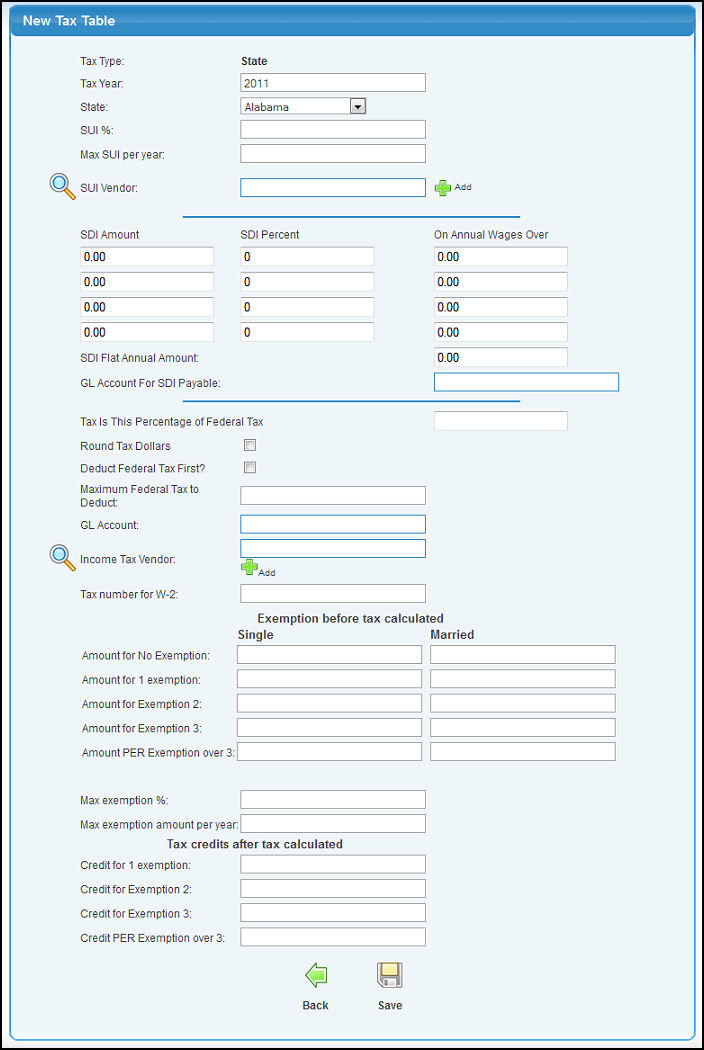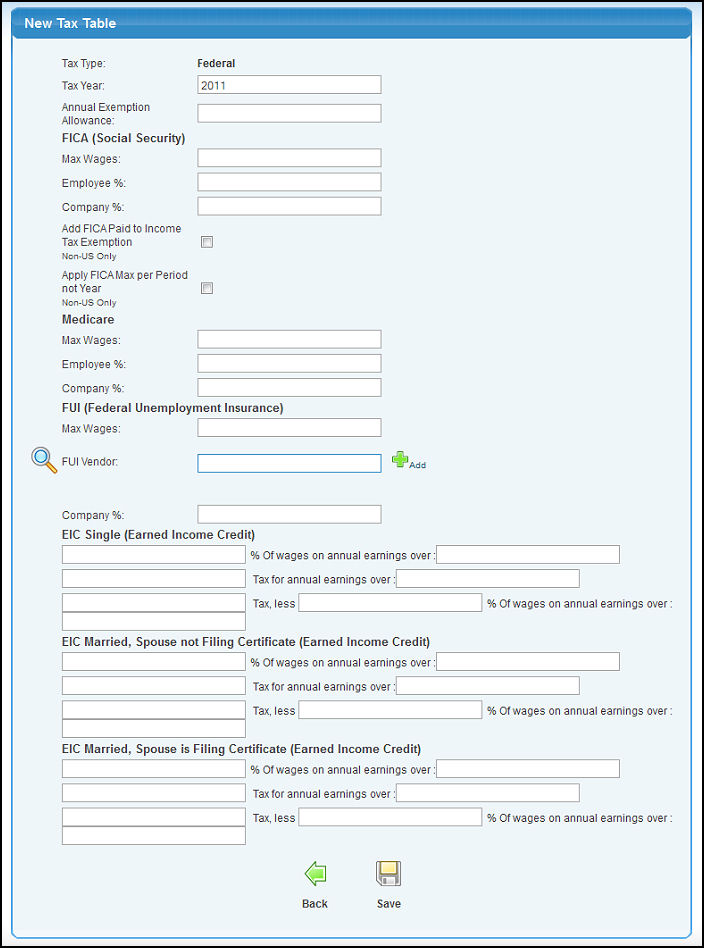Use this section to create new tax districts (whether local, city, federal, school district, etc.) and enter some general information about the tax and deductions. The actual tax table information is entered under Enter/Update Tax Tables.
- From the Main Menu, select Payroll -> Tax Tables -> New Tax Type.
- Your screen should look similar to this:

- Select the Local or City or Additional Tax Type from the pull-down list.
- To add a Local, City or Additional Tax Type, click on the
 Add button. Your screen should look similar to this: Add button. Your screen should look similar to this:

- Enter data in the following categories:
- Tax Year: Enter the tax year for this new tax table.
- Name: Enter the Name of tax district. This name will appear on tax forms.
- Check Abbr: Since there may not be room for the full name on checks, etc. this abbreviation is what will show on pay stubs.
- Round Tax Dollars: Check this box if your City or Local tax laws require rounding of the calculated tax amount to the nearest dollar.
- Deduct Federal Tax First: Check the box if you should deduct Federal tax from the total pay before calculating this tax.
- Maximum Federal Tax to Deduct: If you checked the above box (Deduct Federal Tax First), then enter the maximum federal tax to be deducted from wages. Leave this a zero if there is no maximum.
- GL Account: Enter the name of the Payables account into which this tax will accrue until paid to the tax district. USING THE AUTO-LOOKUP FEATURE on GL Account Numbers - Enter the GL Account name or number to see a drop-down list of matching accounts. Highlight the account to enter it into the field. A space bar will bring up ALL accounts valid for this field, HOWEVER this is not recommended due to limitations on the length of the list that can be viewed.
- Income Tax Vendor: This is the Vendor who you pay this tax to. Enter Vendor Name (or any portion of the name) to bring up a drop-down of possible matches. If you want to search by phone, zip code, etc., use the
 Lookup button for detailed searches. By selecting the vendor, the payroll taxes for this district will generate an entry into Payables automatically for the amount accrued. This occurs when writing checks. NOTE: To Add A New Vendor, click on the Lookup button for detailed searches. By selecting the vendor, the payroll taxes for this district will generate an entry into Payables automatically for the amount accrued. This occurs when writing checks. NOTE: To Add A New Vendor, click on the  Add button and follow direction under Add/Update Vendor. Add button and follow direction under Add/Update Vendor.
- Tax number for W-2: Tax id number to show on W2, etc.
- Exemption amounts for each filing status (up to 4 exemptions, above 4 uses the 4th amount): Enter the amount per exemption for each filing status. This is the amount to be deducted from wages prior to calculating tax.
- Max. exemption %: If your tax district only has a ceiling on allowable exemption amounts up to a certain percentage of total wages, enter that percentage here.
- Maximum exemption amount per year: If your tax district has a ceiling on allowable exemption amounts up to a certain maximum amount per year, enter that maximum here.
- Credit amount for exemptions (up to 4 exemptions, above 4 uses the 4th amount): Enter the amount of the credit (a reduction of tax calculated) per exemption.
- To return to the previous screen WITHOUT SAVING your changes, click on the
 Back button. Back button.
- To save the Local or City Tax, click on the
 Save button. You should see a screen simliar to this: Save button. You should see a screen simliar to this:

- To add another Tax Type (and NOT create the Tax Table), click on the
 Back button. Back button.
- To go to the Tax Table Edit section, click on the
 Next button. For instructions on the Tax Table Edit screen, see Tax Table Add/Update in the Related Topics section at the bottom of this Help screen. Next button. For instructions on the Tax Table Edit screen, see Tax Table Add/Update in the Related Topics section at the bottom of this Help screen.
- Select the State Tax Type from the pull-down list.
- Click on the
 Add button. Your screen should look similar to this: Add button. Your screen should look similar to this:

- Enter data in the following categories:
- Tax Year: Enter the Tax Year for the new tax table.
- State: Select the State from the pull-down list.
- SUI%: Enter the State Unemployment Insurance(SUI) percentage to be multiplied times wages to calculate tax.
- Max SUI per Year: Maximum wages on which SUI is to be calculated.
- SUI Vendor: This is the Vendor who you pay this tax to. Enter Vendor Name (or any portion of the name) to bring up a drop-down of possible matches. If you want to search by phone, zip code, etc., use the
 Lookup button for detailed searches. By selecting the vendor, the payroll taxes for this district will generate an entry into Payables automatically for the amount accrued. This occurs when writing checks. NOTE: To Add A New Vendor, click on the Lookup button for detailed searches. By selecting the vendor, the payroll taxes for this district will generate an entry into Payables automatically for the amount accrued. This occurs when writing checks. NOTE: To Add A New Vendor, click on the  Add button and follow direction under Add/Update Vendor. Add button and follow direction under Add/Update Vendor.
- SDI Amount/SDI Percent/On Annual Wages Over: If State Disability Insurance is applicable to your state, it can be entered here. Four rows are available to enter in the SDI amount, percent and annual wages.
- SDI Flat Annual Amount: The annual wage limit for SDI.
- GL Account For SDI Payable: Enter the account name (or partial name) to bring up a list of possible matches.
- Round Tax Dollars: Check this box if your tax laws require rounding of the calculated tax amount to the nearest dollar.
- Deduct Federal Tax First: Check the box if you should deduct Federal tax from the total pay before calculating this tax.
- Maximum Federal Tax to Deduct: If you checked the above box (Deduct Federal Tax First), then enter the maximum federal tax to be deducted from wages. Leave this a zero if there is no maximum.
- GL Account: Enter the name or number of the Payables account into which this tax will accrue until paid to the tax district. USING THE AUTO-LOOKUP FEATURE on GL Account Numbers - Enter the GL Account name or any portion of the number, name or description to see a drop-down list of matching accounts. Highlight the account to enter it into the field. A space bar will bring up ALL accounts valid for this field, HOWEVER this is not recommended due to limitations on the length of the list that can be viewed.
- Income Tax Vendor: This is the Vendor who you pay this tax to. Enter Vendor Name (or any portion of the name) to bring up a drop-down of possible matches. If you want to search by phone, zip code, etc., use the
 Lookup button for detailed searches. By selecting the vendor, the payroll taxes for this district will generate an entry into Payables automatically for the amount accrued. This occurs when writing checks. NOTE: To Add A New Vendor, click on the Lookup button for detailed searches. By selecting the vendor, the payroll taxes for this district will generate an entry into Payables automatically for the amount accrued. This occurs when writing checks. NOTE: To Add A New Vendor, click on the  Add button and follow direction under Add/Update Vendor. Add button and follow direction under Add/Update Vendor.
- Tax number for W-2: Tax id number to show on W2, etc.
- Exemption amounts for each filing status (up to 4 exemptions, above 4 uses the 4th amount): Enter the amount per exemption for each filing status. This is the amount to be deducted from wages prior to calculating tax.
- Max. exemption %: If your tax district only has a ceiling on allowable exemption amounts up to a certain percentage of total wages, enter that percentage here.
- Maximum exemption amount per year: If your tax district has a ceiling on allowable exemption amounts up to a certain maximum amount per year, enter that maximum here.
- Credit amount for exemptions (up to 4 exemptions, above 4 uses the 4th amount): Enter the amount of the credit (a reduction of tax calculated) per exemption.
- To return to the previous screen WITHOUT SAVING your changes, click on the
 Back button. Back button.
- To save the State Tax, click on the
 Save button. You should see a screen simliar to this: Save button. You should see a screen simliar to this:

- To add another Tax Type (and NOT create the Tax Table), click on the
 Back button. Back button.
- To go to the Tax Table Edit section, click on the
 Next button. For instructions on the Tax Table Edit sreen, see Tax Table Add/Update in the Related Topics section at the bottom of this Help screen. Next button. For instructions on the Tax Table Edit sreen, see Tax Table Add/Update in the Related Topics section at the bottom of this Help screen.
- Select the Federal Tax Type from the pull-down list. NOTE: You will not see a Federal Tax option if you have already entered it -- go to the Tax Table UPDATE section to make changes.
- Click on the
 Add button. Your screen should look similar to this: Add button. Your screen should look similar to this:

- Enter data in the following categories:
- Tax Year: Enter the Tax Year for the new tax table.
- Annual Exemption Allowance: Amount to be deducted from YEARLY wages PER EXEMPTION claimed.
- FICA (Social Security):
- Max Wages: Maximum wages on which Social Security Tax is calculated.
- Employee %: Percentage of wages deducted from employee pay for Social Security Tax.
- Company %: Percentage of wages employer contributes to Social Security Tax on each employee.
- Add FICA Paid to Income Tax Exemption: This option is for non-U.S. users only. Checking this box will add the FICA paid to income tax exemption.
- Apply FICA Max per Period not Year: This option is for non-U.S. users only. Check this box to apply the max FICA wages per pay period instead of for the year.
- Medicare:
- Max Wages: Maximum wages on which Medicare Tax is calculated.
- Employee %: Percentage of wages deducted from employee pay for Medicare Tax.
- Company %: Percentage of wages the Employer contributes to Medicare Tax on each employee.
- FUI (Federal Unemployment Insurance):
- Max Wages: Maximum wages on which Federal Unemployment Tax is calculated.
- FUI Vendor: This is the Vendor who you pay this tax to. Enter Vendor Name (or any portion of the name) to bring up a drop-down of possible matches. If you want to search by phone, zip code, etc., use the
 Lookup button for detailed searches. By selecting the vendor, the payroll taxes for this district will generate an entry into Payables automatically for the amount accrued. This occurs when writing checks. NOTE: To Add A New Vendor, click on the Lookup button for detailed searches. By selecting the vendor, the payroll taxes for this district will generate an entry into Payables automatically for the amount accrued. This occurs when writing checks. NOTE: To Add A New Vendor, click on the  Add button and follow direction under Add/Update Vendor. Add button and follow direction under Add/Update Vendor.
- Company %: Percentage of wages the Company contributes for FUI/FUTA (Federal Unemployment Insurance).
- EIC Single (Earned Income Credit): This is for low-income families to receive a tax credit on federal income tax. It is a credit that is applied AFTER the regular income tax is calculated. Enter the percentages and amounts as noted by the "___" below:
- ____ % of wages on annual earnings over $___.
- $___ Tax for annual earnings over $___.
- $___ Tax, less __% of wages on annual earnings over $____.
- EIC Married-Spouse is NOT Filing Certificate: This is for low-income families to receive a tax credit on federal income tax. It is a credit that is applied AFTER the regular income tax is calculated. Enter the percentages and amounts as noted by the "___" below:
- ____ % of wages on annual earnings over $___.
- $___ Tax for annual earnings over $___.
- $___ Tax, less __% of wages on annual earnings over $____.
- EIC Married-Spouse is Filing Certificate: This is for low-income families to receive a tax credit on federal income tax. It is a credit that is applied AFTER the regular income tax is calculated. Enter the percentages and amounts as noted by the "___" below:
- ____ % of wages on annual earnings over $___.
- $___ Tax for annual earnings over $___.
- $___ Tax, less __% of wages on annual earnings over $____.
- To return to the previous screen WITHOUT SAVING your changes, click on the
 Back button. Back button.
- To save the Federal Tax, click on the
 Save button. You should see a screen simliar to this: Save button. You should see a screen simliar to this:

- To add another Tax Type (and NOT create the Tax Table), click on the
 Back button. Back button.
- To go to the Tax Table Edit section, click on the
 Next button. For instructions on the Tax Table Edit screen, see Tax Table Add/Update in the Related Topics section at the bottom of this Help screen. Next button. For instructions on the Tax Table Edit screen, see Tax Table Add/Update in the Related Topics section at the bottom of this Help screen.
|

 Add button. Your screen should look similar to this:
Add button. Your screen should look similar to this: 
 Lookup button for detailed searches. By selecting the vendor, the payroll taxes for this district will generate an entry into Payables automatically for the amount accrued. This occurs when writing checks. NOTE: To Add A New Vendor, click on the
Lookup button for detailed searches. By selecting the vendor, the payroll taxes for this district will generate an entry into Payables automatically for the amount accrued. This occurs when writing checks. NOTE: To Add A New Vendor, click on the  Back button.
Back button. Save button. You should see a screen simliar to this:
Save button. You should see a screen simliar to this: 
 Next button. For instructions on the Tax Table Edit screen, see Tax Table Add/Update in the Related Topics section at the bottom of this Help screen.
Next button. For instructions on the Tax Table Edit screen, see Tax Table Add/Update in the Related Topics section at the bottom of this Help screen.

